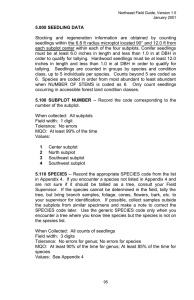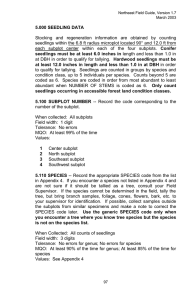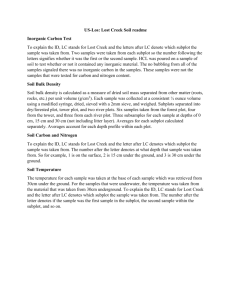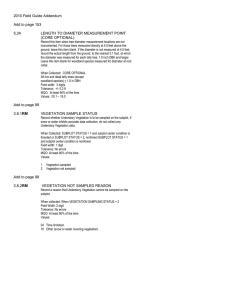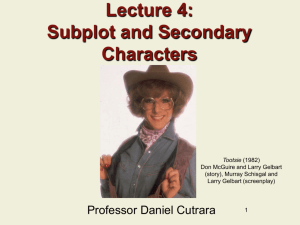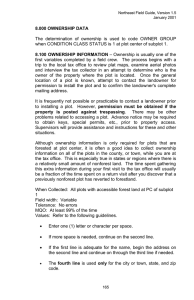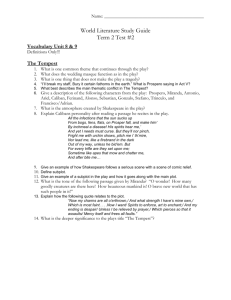Stocking and regeneration information are obtained by counting seedlings
advertisement
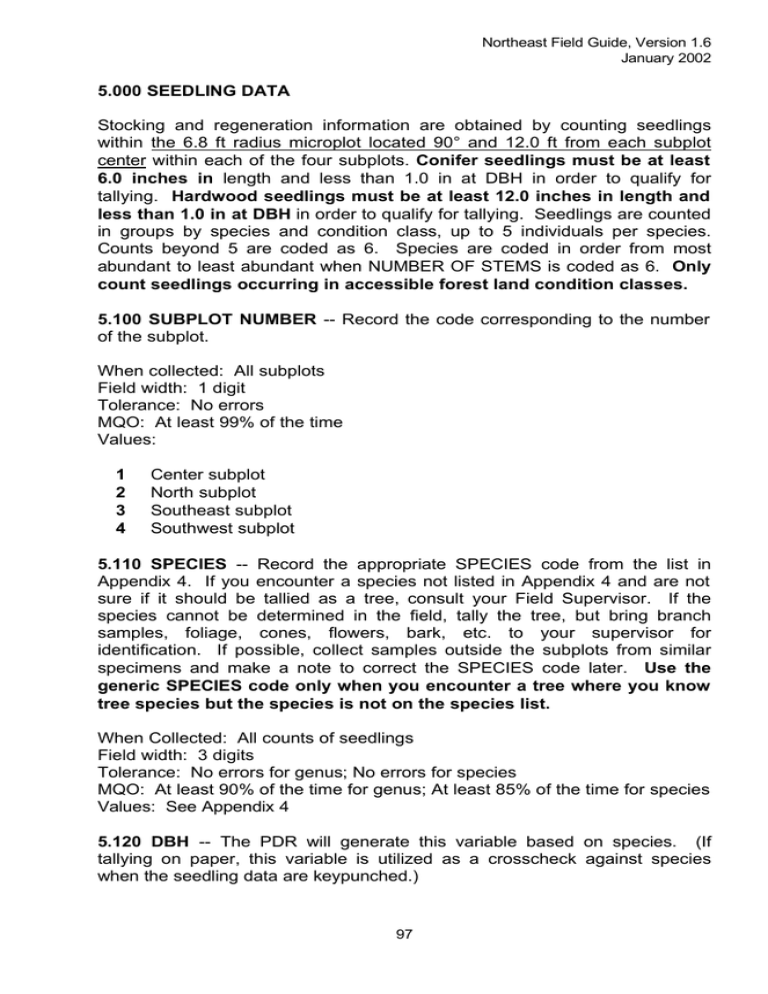
Northeast Field Guide, Version 1.6 January 2002 5.000 SEEDLING DATA Stocking and regeneration information are obtained by counting seedlings within the 6.8 ft radius microplot located 90° and 12.0 ft from each subplot center within each of the four subplots. Conifer seedlings must be at least 6.0 inches in length and less than 1.0 in at DBH in order to qualify for tallying. Hardwood seedlings must be at least 12.0 inches in length and less than 1.0 in at DBH in order to qualify for tallying. Seedlings are counted in groups by species and condition class, up to 5 individuals per species. Counts beyond 5 are coded as 6. Species are coded in order from most abundant to least abundant when NUMBER OF STEMS is coded as 6. Only count seedlings occurring in accessible forest land condition classes. 5.100 SUBPLOT NUMBER -- Record the code corresponding to the number of the subplot. When collected: All subplots Field width: 1 digit Tolerance: No errors MQO: At least 99% of the time Values: 1 2 3 4 Center subplot North subplot Southeast subplot Southwest subplot 5.110 SPECIES -- Record the appropriate SPECIES code from the list in Appendix 4. If you encounter a species not listed in Appendix 4 and are not sure if it should be tallied as a tree, consult your Field Supervisor. If the species cannot be determined in the field, tally the tree, but bring branch samples, foliage, cones, flowers, bark, etc. to your supervisor for identification. If possible, collect samples outside the subplots from similar specimens and make a note to correct the SPECIES code later. Use the generic SPECIES code only when you encounter a tree where you know tree species but the species is not on the species list. When Collected: All counts of seedlings Field width: 3 digits Tolerance: No errors for genus; No errors for species MQO: At least 90% of the time for genus; At least 85% of the time for species Values: See Appendix 4 5.120 DBH -- The PDR will generate this variable based on species. (If tallying on paper, this variable is utilized as a crosscheck against species when the seedling data are keypunched.) 97 5.000 – Seedling Data Northeast Field Guide, Version 1.6 January 2002 When Collected: All counts of seedlings Field width: 3 digits Tolerance: No errors MQO: At least 99% of the time Value: 001 5.140 REPRODUCTION NUMBER -- Assign a three-digit reproduction number for each item, or line, of seedlings that is tallied. Regeneration numbers begin at 001 on each subplot and increase sequentially in order as each line of data is recorded. When Collected: All counts of seedlings Field width: 3 digits Tolerance: No errors MQO: At least 99% of the time Values: 001 to 099 5.200 CONDITION CLASS NUMBER -- On a plot, assign and record a unique identifying number for each condition class. At the time of the plot establishment, the condition class at plot center (the center of subplot 1) is designated condition class 1. Other condition classes are assigned numbers sequentially at the time each condition class is delineated. On a plot, each sampled condition class must have a unique number that can change at remeasurement to reflect new conditions on the plot. When collected: All counts of seedlings Field width: 1 digit Tolerance: No errors MQO: At least 99% of the time Values: 1 to 9 5.300 NUMBER OF STEMS --Record the number of seedlings of each species, by condition class. Count up to 5 individuals by species; code 6 if there are more than 5 individuals of any given species in any given condition class. In the case of stump sprouts, record only one seedling from a single stump or mortality. Do not count sprouts on live trees. Code species in order from most abundant to least abundant when NUMBER OF STEMS is coded as 6. When Collected: Each accessible forest land condition class on each microplot Field width: 2 digit Tolerance: No errors MQO: At least 95% of the time Values: 01 to 05 (exact count); 06 (more than 5 individuals by species by condition class) 98 5.000 – Maine Shrub & Vine Data Northeast Field Guide, Version1.6 January 2002 SHRUB AND VINE DATA FOR THE MAINE INVENTORY Additional vegetation information is obtained by counting shrubs, dwarf shrubs and vines within a 3.7 ft radius milacre plot located 90° and 12.0 ft from each subplot center within each of the four subplots. Shrubs are counted in groups by species and condition class, up to 99 individuals per species. Counts beyond 99 are coded as 99. Dwarf shrubs and vines are tallied by occurrence and condition class. Individual counts of specimens are not necessary for these life forms. Only count shrubs, dwarf shrubs and vines occurring in accessible forest land condition classes. 5.110 SPECIES -- Record the appropriate SPECIES code from the list in Appendix 4. If you encounter a species not listed in Appendix 4 and are not sure if it should be tallied, consult your Field Supervisor. If the species cannot be determined in the field, tally the shrub, dwarf shrub or vine, but bring branch samples, foliage, cones, flowers, bark, etc. to your supervisor for identification. If possible, collect samples outside the subplots from similar specimens and make a note to correct the SPECIES code later. Use the generic SPECIES code only when you encounter a shrub etc. where you know the species but the species is not on the species list. When Collected: All counts of shrubs, dwarf shrubs and vines -- Maine Field width: 3 digits Tolerance: No errors for genus; No errors for species MQO: At least 90% of the time for genus; At least 85% of the time for species Values: See Appendix 4 5.100 SUBPLOT NUMBER -- Record the code corresponding to the number of the subplot. When collected: All subplots -- Maine Field width: 1 digit Tolerance: No errors MQO: At least 99% of the time Values: 1 2 3 4 Center subplot North subplot Southeast subplot Southwest subplot 99 5.000 – Maine Shrub & Vine Data Northeast Field Guide, Version1.6 January 2002 5.140 REPRODUCTION NUMBER -- Assign a three-digit reproduction number for each item, or line, of shrubs, etc. that is tallied. Regeneration numbers begin at 001 on each subplot and increase sequentially in order as each line of data is recorded. When Collected: All counts of shrubs, dwarf shrubs and vines – Maine Field width: 3 digits Tolerance: No errors MQO: At least 99% of the time Values: 001 to 099 5.200 CONDITION CLASS NUMBER -- On a plot, assign and record a unique identifying number for each condition class. At the time of the plot establishment, the condition class at plot center (the center of subplot 1) is designated condition class 1. Other condition classes are assigned numbers sequentially at the time each condition class is delineated. On a plot, each sampled condition class must have a unique number that can change at remeasurement to reflect new conditions on the plot. When collected: All counts of shrubs, dwarf shrubs and vines – Maine Field width: 1 digit Tolerance: No errors MQO: At least 99% of the time Values: 1 to 9 5.300 NUMBER OF STEMS --Record the number of shrubs of each species, by condition class. If a shrub forks at, or above one inch above ground level, the stem count is one. If the shrub forks below one inch, then the stem count is two or more. Count up to 99 individuals by species. When Collected: Each accessible forest land condition class on each milacre plot -- Maine Field width: 2 digit Tolerance: No errors MQO: At least 95% of the time Values: 1 to 99 100
